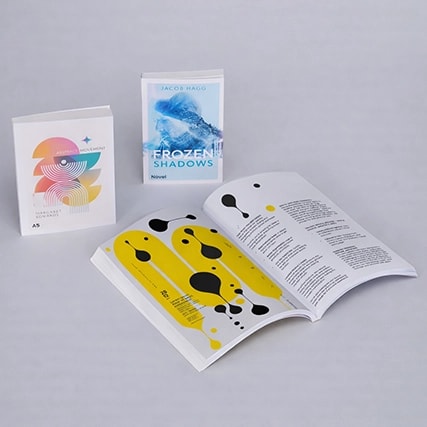Our top tips for self-publishing your own book
For years, getting published meant gatekeepers everywhere you looked. Agents. Editors. Approval. Rejection letters. But not any more. Once seen as a last resort, self-publishing no longer carries the same stigma that it used to. From fantasy novels and business books to memoirs and poetry collections, it is a £1.25 billion global industry, with more than 2.6 million books self-published worldwide in one fiscal year, with over half attributed to Amazon's Kindle Direct Publishing. Writers who self-publish can retain up to 70% of royalties, compared to as little as 5-15% with traditional publishers.
But successful self-publishing isn't about uploading a manuscript to Amazon and that's that. Not at all. If it was, everyone would be doing it. No, successful self-publishing is about preparation, polish and partnering with the right people.
Here are our top tips to make your book not only real, but remarkable.
1. Start with your reader in mind
Every story starts with a reason, but every successful book starts with a reader. Before you write your first chapter or settle on a title, ask yourself:
- Who will this book be for?
- Why will they care?
- Where do they hang out - online or in-person?
Research shows that genre familiarity is the #1 reason readers pick up a book, followed closely by recommendations and cover art. That means if you're writing a dystopian novel, your audience isn't everyone; it's likely fans of the Hunger Games, the 100 or Black Mirror. Speak to them in a way that they understand.
2. Finish the draft and walk away
One of, if not the biggest editing mistakes? Editing too soon. It's very easy to do too. The easiest solution is to take a break. Writing expert Conor Murphy (The Writing Cooperative) recommends pausing before editing to detach emotionally and catch structural issues more effectively. He susggests that even a short break, like a day or two, significantly improves editorial clarity. And, without the incessessant need to edit as soon as you've finished writing, you stand in a neutral ground that prevents writing for the sake of writing, which is always detrimental.
And, if you really want fresh perspective, print it out. There's something about seeing your words on tangible paper that instantly reveals what is working, and what isn't.
3. Don't edit alone
It's very easy to get lost in the thick of things. After a while, you reach a point where you come to live inside the manuscript. You know it too well. Well enough that you become ignorant to all of the mistakes you've made and the mistakes you'll continue to make going forward. That is why outside opinions are ideal.
It is nerve-wracking asking people to look at your work because there is something so vulnerable about writing something dear to you, but it is an important step. Whether beta readers, writing groups or professional editors, you shouldn't skip this step. A Jane Friedman analysis of beta reader use, based on 92 responses from her author research, shows how critical early feedback is for spotting plot gaps, inconsistencies or tone issues.
4. Choose the right font (seriously)
Your font is the voice on the page. Choose one that doesn't whisper or shout, but speaks clearly. Serif fonts, like Garamond, Georgia or Palatino, are easier on the eyes for long-form reading. MIT research shows readers retain 18% more when content is printed in a readable serif font versus modern sans-serif or decorative ones.
Before printing professionally, test it on some printed copies with your various typefaces. If it feels hard to read after ten minutes, your audience will likely feel the same.
5. Design a cover that opens doors
There is a reason why authors like Colleen Hoover and Adam Kay dominate the charts, because their covers grab attention. The age-old fibbage of not judging a book by its cover is no longer relevant today, with covers bigger, brighter and better than ever. In the world of social media and low attention spans, the average book cover has 2 to 5 seconds to sell itself or the sale is gone.
Skip the fuss and create a great cover that reflects your genre (be it thriller, romance, business), use colour psychology and layout with intention and above all else, highlight your title and name clearly. People want to know what and who they are reading. Pinterest serves as a great inspiration for ideas, or better yet, head into your local Waterstones and see what catches your eye, and then adapt.
6. Build buzz before you print
Gone are the days are where you can just write, print and hope. Now it is all about teasing, building communities and launching. The process of writing a book is more so about business and marketing than it is praying at this point, which is arguably for the better. Many modern day indie authors begin promoting 1-3 months before their book release to generate buzz and get people talking.
How? Whether that's building a community of likeminded individuals, offering incentives for commitments, building landing pages for pre-orders or giving your customers something to engage for. At the end of the day, those diehard fans are going to get the books anyway, and by appeasing to others, you are more likely to get that number up for when your book finally does go to print. It's good, shrewd business.
7. Use smart, low-budget marketing
You don't need a PR team. Just a plan. When it comes to book discoveries, the vast majority of readers rely on recommendations to find their next good book. Whether that's from friends, family, librarians or even social media, getting in front of people is key.
You could start a trend on TikTok, run a giveaway on Facebook, offer signed copies. Anything to get people talking.
8. Stay realistic
One of the biggest downsides to self-publishing is that most self-published books won't hit bestselling lists ever. But that's okay. Only 0.03% of books ever sell more than 100,000 copies, but for many authors, selling 500 to 1,000 to the right audience is a huge win. More importantly: it's yours. Your voice. Your design. Your book. Nobody can take that away from you. Don't let that stop you here.
9. Print with a professional printing company
When I say professional printing company, note that I do not mean publisher. After all, this is a blog about self-publishing. No, I mean companies like us. Because despite the growth of eBooks, the UK print book market still surpassed £7 billion. Print still continues to prove the most viable option, because people like tangible things.
Whether that means you print your novel as a small print run to hit the ground running or you host a giveaway where some lucky customers could win a signed, limited-edition hardback book, we don't just print your book, we help you bring it to life with quality that rivals any publisher.
This is your story
Own it. Self-publishing isn't a shortcut. In fact, it is even more involved than publishing through a professional publisher. It is a creative act of independence, and one that is more accessible than ever. Whether you're printing a memoir, launching a business book or finally releasing that novel you've been sitting on, WTTB gives you the tools, quality and guidance to do it right.
Posted on August 1, 2025 by Miller Lane-Williams
Related topics:



